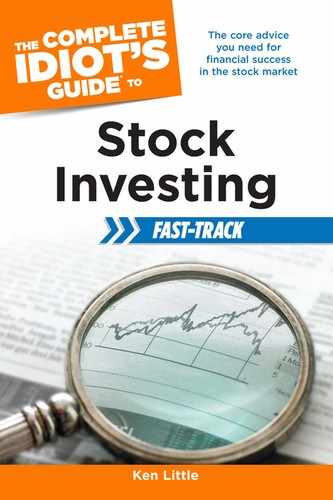Contents
Important Part of Investment Plan
Buying the Business, Not the Stock
Relating a Company’s Value to Stock Price
The Market Moves in Mysterious Ways
Will I Achieve My Financial Goals?
Having Reasonable Expectations
The Traps of Trading—Your Biggest Risk
3 Finding and Understanding Information
Finding Information on the Internet
Using Morningstar’s Stock Screen
Company Reports (Financially) Tell All
Three Main Financial Statements
The Balance Sheet Must Balance
Liabilities: What the Company Owes
Shareholders Equity: Value to Investors
The Income Statement Is Home to Bottom Line
Expenses: The Cost of Doing Business
Operating Income: Sales Minus Cost of Sales
Statement of Cash Flows Tracks Cash In and Out
Cash Flows from Operating Activities
Cash Flows from Financing Activities
What the Statement of Cash Flows Tells You
Taking a Chance on Growth Stocks
No Clear Answers on Stock Prices
How Daily Stock Prices Are Set
Price and Value Are Not the Same
Intrinsic Value Determines Potential Success
Analyzing a Company’s Economic Moat
Strong History of Making Money
Evaluating an Economic Moat’s Width and Depth
Durability of an Economic Moat
The Next Step: Analyzing the Business
Intrinsic Value Using Discounted Cash Flows
Understanding Discounting and Future Value
The Weakness of the Discounted Cash Flow Model
The Strengths of the Discounted Cash Flow Model
Alternative to Discounted Cash Flow Method
A Planned Approach to Buying and Selling
When to Buy Different Types of Stocks
Understanding Asset Allocation
Asset Allocation and Diversification
The Importance of Asset Allocation
Those Other Two Asset Classes: Fixed Income and Cash
Fixed-Income Securities (Bonds)
How to Build a Portfolio That Fits You
Fixed-Income (Bonds) Asset Class
9 Getting Started with a Stockbroker
Which Broker Type Is Right for You?
Discount/Online Brokers Accounts
Stock Market Orders You Should Know
Placing an Order with Your Broker
How to Keep Investing Expenses Low
What You Do When Things Go Badly
Financial Industry Regulatory Authority (FINRA)
10 Mistakes to Avoid and Tools to Use
Common Investing Mistakes and How to Avoid Them
Fall in Love with a Stock or a Company
